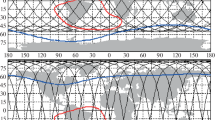Abstract
To estimate the protective properties of a space suit against cosmic radiation the dose rates were calculated for extravehicular activity in the ISS orbit for a number of representative points of critical organs of the human body. The screening functions of the Orlan-M space suit obtained by the authors earlier are used in the calculations. In addition, the effect of East-West asymmetry of the fluxes of high-energy protons trapped by the geomagnetic field is taken into account. It is shown that during passages through the South Atlantic Anomaly, choosing the optimal orientation of astronauts in relation to the cardinal directions, one can achieve for the most critical body organs a dose rate reduction by a factor of ∼1.5–1.8 (in the maximum of solar activity) and by a factor of ∼2–2.5 (in the solar activity minimum). The obtained results can serve for obtaining more accurate estimation of radiation risk for astronauts working in the Orlan-M space suit in the near-terrestrial orbits and for elaborating practical recommendations to reduce their radiation exposures.
Similar content being viewed by others
References
Shafirkin, A.V., Kolomenskii, A.V., and Petrov, V.M., Levels of Radioactive Action and Radiation Risk for Flights on the Mir Orbital Complex and International Space Station, Kosm. Biol. Aviakosm. Med., 2001, vol. 35, no. 5, pp. 25–31.
Radiation Protection Studies of International Space Station Extravehicular Activity Space Suits, Cucinotta, F.A., Shavers, M.R., Saganti, P.B., and Miller J., Eds., NASA TP-2003-212051, December 2003.
Kolomenskii, A.V., Laiko, Yu.A., Red’ko, V.I., and Shurshakov, V.A., Determination of the Thickness of Soft Shell of a Space Suite by the Beta Testing Method, Raketno-Kosmicheskaya Tekhnika, Ed. By Energiya Rocket-Space Corporation, Ser. XII, no. 1–2, pp. 134–138.
Kartashov, D.A., Kolomenskii, A.V., and Shurshakov, V.A., A Method of Calculating Self-Shielding for Critical Organs of Human Body in Anthropomorphic Phantom, Kosm. Biol. Aviakosm. Med., 2004, no. 2, pp. 52–56.
De Angelis, G., Anderson, B.M., Atwell, W., et al., Astronaut EVA Exposure Estimates from CAD Model Spacesuit Geometry, J. Radiation Research, 2004, vol. 45 P, pp. 1–9.
Johnson, A.S., Golightly, M.J., Weyland, M.D., et al., Minimizing Space Radiation Exposure During Extra-Vehicular Activity, Adv. Space Res., 2005, vol. 36, pp. 2524–2529.
Shurshakov, V.A., Kartashov, D.A., Kolomenskii, A.V., et al., Radiation-Protective Properties of Space Suite Orlan-M as Applied to Conditions of Extravehicular Activity in the ISS Orbit, Kosm. Biol. Aviakosm. Med., 2006, vol. 41, no. 4, pp. 56–61.
Kartashov, D.A. and Shurshakov, V.A., Method of Determining Effective Dose Rate for Astronauts Irradiated in Orbital Flight during Extravehicular Activity, in Nauchnaya sessiya MIFI-2006. Astrofizika i kosmofizika, Sbornik nauchnykh trudov (Science Workshop MEPHI-2006 on Astrophysics and Cosmophysics: Collection of Papers), Moscow: MIFI, 2006, pp. 78–79.
Mitrikas, V.G., Estimates of Radiation Doses for Astronauts Participating in Extravehicular Activity on the International Space Station, Kosm. Biol. Aviakosm. Med., 2007, vol. 40, no. 4, pp. 49–53.
Abramov, I.P., Severin, G.I., Stoklitskii, A.Yu., and Sharipov, R.Kh., Skafandry i sistemy dlya raboty v otkrytom kosmose (Space Suites and Systems for Operation in the Open Space), Moscow: Mashinostroenie, 1984.
Hess, W.N., The Radiation Belt and Magnetosphere, Waltham, Mass.: Blaisdell Publ. Co., 1968.
Benghin, V.V., Petrov, V.M., Shurshakov, V.A., and Muratova, I.A., Parameters of Angular Distributions of Trapped Protons in the South Atlantic Magnetic Anomaly, Kosm. Issled., 1991, vol. 29, no. 6, pp. 905–909.
Benghin, V.V., Panova, N.A., Petrov, B.M., and Shurshakov, V.A., Radiation Fields Specific to the South Atlantic Anomaly, Nuclear Tracks Radiation Measurements, 1992, vol. 20, no. 1, pp. 25–28.
Kruglanski, M., Engineering Tool for Trapped Proton Flux Anisotropy Evaluation, Radiation Measurements, 1996, vol. 26, no. 6, pp. 953–958.
GOST (State Standard) 25645.203-83: Human Body Model for Calculations of Tissue Dose Rates, Moscow: Gosstandart SSSR, 1984.
Sawyer, D.M. and Vette, J.I., AP-8 Trapped Proton Environment for Solar Maximum and Solar Minimum, NSSDC 76-06, 1976.
Bilitza, D., Models of Trapped Particle Fluxes AE-8 (Electrons) and AP-8 (Protons) in Inner and Outer Radiation Belts, NSSDC Code 633, Greenbelt, Maryland: October, 1987.
Circumterrestrial Space (Reference Data), Johnson, F.S., Ed., 1965. Translated under the title Okolozemnoe kosmicheskoe prostranstvo (spravochnye dannye), Moscow: Mir, 1966.
ICRP 1990. Recommendations of the International Commission on Radiological Protection, Publication 60, Annals of the ICRP 21 (1–3), Oxford: Pergamon Press, 1991.
Author information
Authors and Affiliations
Additional information
Original Russian Text © D.A. Kartashov, V.A. Shurshakov, A.V. Kolomenskii, 2011, published in Kosmicheskie Issledovaniya, 2011, Vol. 49, No. 6, pp. 520–525.
Rights and permissions
About this article
Cite this article
Kartashov, D.A., Shurshakov, V.A. & Kolomenskii, A.V. Optimization of radiation exposures during extravehicular activity using the effect of the West-East asymmetry of the fluxes of trapped protons. Cosmic Res 49, 504–509 (2011). https://doi.org/10.1134/S0010952511060050
Received:
Published:
Issue Date:
DOI: https://doi.org/10.1134/S0010952511060050




